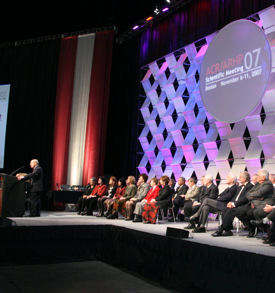The Colonoscopy Conundrum
Studies suggest the importance of screening, but convincing patients is another matter.
PHILADELPHIA—If anything could make a trip to the dentist sound appealing by comparison, it would be a visit to the endoscopist. Compliance rates for colonoscopy screenings are famously low. Yet research presented at the Annual Scientific Meeting of the American College of Gastroenterology in October shows just how important it is to be screened, particularly for African-Americans, Hispanics and the elderly.
One study retrospectively analyzed the results of 78 African-American and 502 Caucasian colonoscopies, and found that 14% of African-Americans had advanced right-sided polyps compared with 5.4% of Caucasians. A second study of 756 colonoscopies found comparable rates of pathologically significant lesions among Hispanics (48%) and African-Americans (46%), as well as similar rates of pathologically significant right-sided polyps (57% of Hispanics, 62% of African-Americans).
Lead authors of both studies suggested that colonoscopy, which can detect right-sided lesions, may make more sense for these minority populations than flexible sigmoidoscopy, which won't detect those lesions.
Separately, an age-related analysis found that colorectal adenomas were more common in patients age 80 or older (36%) than those younger than 80 (20%). Another study of symptomatic versus asymptomatic patients found that screening colonoscopy improved survival among patients up to age 84, because it led to earlier diagnosis of colorectal cancer.
“There is a role for screening colonoscopy in asymptomatic individuals without significant comorbidities up to age 84,” concluded Emily Singh, lead author of the second study.
Colonoscopy: A hard sell
Unfortunately, some of the populations that are most at risk of developing colorectal cancer are the least likely to be screened. Hispanics, African-Americans and Asians, as well as people of lower education and income, are less likely to be screened than other groups, noted John Inadomi, MD, chief of clinical gastroenterology at San Francisco General Hospital.
Aversion to bowel preparation and a fear of discomfort are the top reasons that people avoid colonoscopy, with embarrassment close behind, Dr. Inadomi said. Not surprisingly, studies show that the most effective ways to convince a patient to have a colonoscopy are assurance that sedation will prevent discomfort, using a less noxious bowel preparation, ensuring that insurance will pay for the screening and having the endoscopist be of the same gender as the patient.
“Women in particular prefer to have a female endoscopist,” Dr. Inadomi said. “87% will wait 30 days or more to have the procedure if they can be guaranteed it will be done by a woman, and 14% will pay more for that guarantee.”
Still, the most important thing is convincing the patient that it's not going to hurt.
“Once the patients have the colonoscopy, they are always fine. But it's the perception of what it entails that prevents people from getting screened. So that's what we have to act on,” Dr. Inadomi said.
Several studies suggest patients are more likely to accept, and repeat, bowel preparations for colonoscopy when they are given at lower volumes, Dr. Inadomi said. While study patients didn't seem to care whether they were given two liters of polyethylene glycol solution (PEG) or 90 milliliters of sodium phosphate, they did prefer the latter when the alternative was bumped to four liters of PEG—suggesting volume is more important to patients than the type of preparation.
Some patients are more likely to have screening done if they are told to undergo a certain procedure, rather than given a choice. A pilot study of 41 patients led by Dr. Inadomi found that people were more likely to get screened when counseled only about the option of colonoscopy, than when given a choice between colonoscopy and fecal occult blood test plus flexible sigmoidoscopy. Those results are now being tested in a 1,000-subject trial, he said.
With so much at stake, Dr. Inadomi observed, “we have to be more paternalistic about (advising people) to get screened.”



